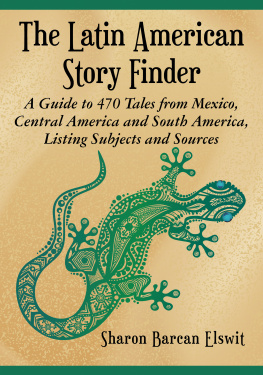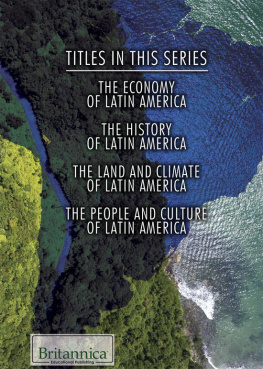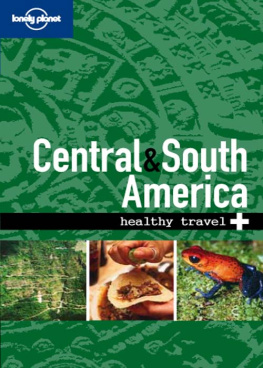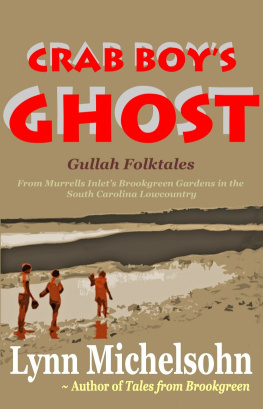Also by SHARON BARCAN ELSWIT
The East Asian Story Finder: A Guide to 468 Tales from China, Japan and Korea, Listing Subjects and Sources (McFarland, 2014 [2009])
The Jewish Story Finder: A Guide to 668 Tales Listing Subjects and Sources, 2d ed. (McFarland, 2012)
The Latin American Story Finder
A Guide to 470 Tales from Mexico, Central America and South America, Listing Subjects and Sources
Sharon Barcan Elswit

McFarland & Company, Inc., Publishers
Jefferson, North Carolina
LIBRARY OF CONGRESS CATALOGUING DATA ARE AVAILABLE
BRITISH LIBRARY CATALOGUING DATA ARE AVAILABLE
e-ISBN: 978-1-4766-2229-3
2015 Sharon Barcan Elswit. All rights reserved
No part of this book may be reproduced or transmitted in any form or by any means, electronic or mechanical, including photocopying or recording, or by any information storage and retrieval system, without permission in writing from the publisher.
Front cover image Juliia76/iStock/Thinkstock
McFarland & Company, Inc., Publishers
Box 611, Jefferson, North Carolina 28640
www.mcfarlandpub.com
In memory of my mother,
who got me started on a lifetime of sharing
stories with children by reading aloud each day
Acknowledgments
Much appreciation goes to the New York Public Library and the MidHudson Library System for their wonderful collections of books.
I am grateful to Constance Vidor for suggesting that this one come next and to Susan Bromberg Skolnick for sharing the stories as I discovered them.
Thank you, John Bierhorst, for the graceful scholarship of your own work and your kindness in answering questions.
I owe special thanks to my daughter Kate, keeper of gates for the Community chapter, and to Michael, who accompanied me everywhere on this journey.
I was going to bring you a plateful of the wedding food, canapes, and all, but there at the street corner a dog snatched it out of my hands.
Teodora Paliza in The She-Calf, story #335
Preface
Everything is possible when you step into the magically real world of Latin American folklorea buzzard can change places with a wifes lazy husband; a hunter may hurl lightning bolts and thunder down on the tribesmen who cheated him of his share of the meat; a shapeshifting pink dolphin from the Amazon may seduce a young woman to his underwater city; and the lizard a padre scoops off a dusty road may become an emerald when he hands it to a poor peasant who needs to buy medicine for his wife. Here, a lone man after a cataclysmic flood sees his black dog slip out of its skin and become a young woman who cooks tortillas and will become his companion in the new world. The folktales deal with timeless key human questions, and there are human truths in the magic they contain.
Which 470 Stories Are Here?
This Latin American Story Finder is a guide to selected tales told in 21 countries, where stories from people in over 75 indigenous tribes melded with the culture of Spanish and Portuguese colonials who arrived in the 16th century. Tales collected and told by Catholic missionaries and Sephardic Jews fleeing the Inquisition from Europe also were adopted and changed by native Quechua, Maya, and Amazonian cultures. And then, added to the mix are the myths from the ancient Inca and Maya civilizations, Anansi stories which came over with African slaves, and tales told by indentured servants from India.
This mix makes the stories richly captivating and unique, and yet they have been greatly underrepresented in both folklore collections and individual books in English. I hope this book can change that. My job is to pick interesting stories for people to use. This guide points the way to tales of transformation, with supernatural beings and many magical objects; tales of love and devotion; tricksters; journeys up to the sky, underwater, and under the earth; reversals of fortune, and stories which explore the workings of nature and the relationship between gods and humans. These stories were told to make sense of the world people could not control, to reinforce traditions, and to pass along wisdoms. They cry out to be shared.
What Is in the Tales?
Especially present in the Latin American tales are stories of how things came to be and why they are what they are. A buzzard carefully rebuilds a jaguar queens eyesight with resin after she loses her own eyes which she has sent flying out over the lake on a lark. This resin accounts for the gleam found in all big cats eyes. Even the tales that do not center on a particular plant or animal or celestial body will end and thats why. We learn where corn and parrots came from, why the moon didnt marry the sun, how curious humans climbed down a rope from a hole in sky to reach earth, and how laughter originated when bat-people tickled a Cayapo man.
There is both earthiness and fantasy in many of the tales. A dog which the Quechua courier hits with a stone next appears as a beguiling young woman whose hip is sore. A Warao man resists being herded with the others from his tribe who are docilely being transformed into peccaries day by day, complete with bristles and multiple teats. A Maya husband ends up with two heads for a while, when he salts the neck of his witch-wifes headless body so her head cannot reattach.
The folktales share an interest in teaching values and taboos, the religious and social mores of their cultures. A Miskito husband discovers that the living belong with the living, when he accompanies his beloved wife who has just died to Mother Scorpion country. Punishment is meted out for shirking work; for being disrespectful to a parent; for cutting down too many trees or hunting more animals than are needed for food; for not being generous; and for being boastful, vain, or greedy. A toad who disparages the smell of the buzzard who is kindly giving him a ride through the air gets dumped off in one Maya tale. A magic canoe which thunks on feet in a story by the Kamaiur people of Brazil swallows the fisherman who does not give it his first catch of fish. The outsider Asin in a tale by the Pilaga people of Bolivia sets a deep freeze over the land where people have ridiculed him for being different.
The Ancestors Are All Around Us reads the title of one story from the Ona people, who even now blow a kiss to the spirits when they leave the house or go on a journey. Humans who do not show gratitude and respect to the gods or spirits in nature suffer. It took five tries for the Aztec gods to create humans who did not neglect them.
The folktales also teach resilience in the face of economic, political, and social hardship. They bring solace through humor. Indigenous people may struggle to earn a living compared with the Spanish colonials, but little Rabbit in the trickster tales will outsmart the larger and more powerful Coyote who is after him every time. Mischievous exploits where Pedro de Urdemalas makes fools of gullible owners and fancy horsemen are celebrated in Chile, Argentina, Mexico, Brazil, and Guatemala.
New realities transformed old stories on both sides when Christian belief in a single God met indigenous belief in many gods, who may be the duenos, or owners, of hills, lakes, and other places in the natural world, which also are home to souls and spirits. The beloved Mexican Virgin of Guadalupe is described as having beautiful dark skin and long black hair. The Brazilian one-eyed monster Mapinguari tears apart the hunter who insists on hunting even on a Sunday. The Virgin Mary replaces the fairy godmother in a Mexican Cinderella tale, where young Maria goes looking for the fish which made off with entrails her mean stepmother sent her to wash and ends up calming a crying baby Jesus. A cat and dog in an African American slave tale from Guadalupe go to ask God whether life goes on after death. As Juan Carlos Galeano writes, Amazonian realities are still a present and active part of the lives of the non-indigenous, who now represent the majority of the population in most cities throughout the region.
Next page









